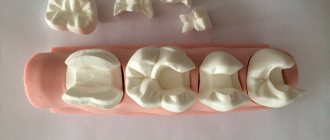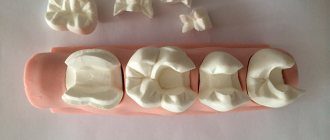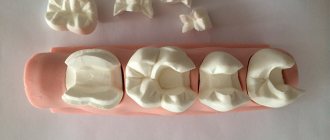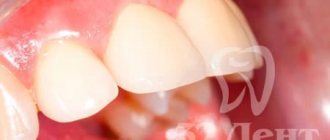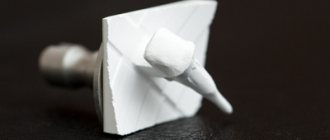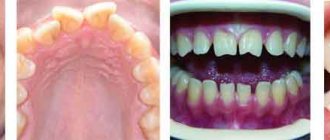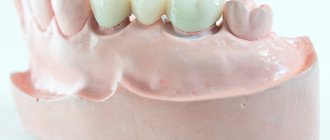A stump inlay is a microprosthesis, which is a tooth stump made of metal, ceramics or zirconium dioxide. It is used when there is significant destruction of the crown part of the tooth and the root is intact. The prosthesis fills the resulting void and creates a support on which an artificial crown is placed. Before installing the inlay, the tooth must be depulped.
A tooth stump inlay is a reliable prosthetic method. With a well-sealed canal and the choice of high-quality materials (for example, gold), it lasts up to 15–20 years.
At the Mitino Dental Center you can get advice from a qualified orthopedic dentist, as well as perform any type of dental prosthetics.
Stump tab for a crown: what is it?
Stump inlays in dentistry are a special type of solid-cast structures that are used in the process of restoration of heavily damaged units. If there is significant tissue destruction, a conventional pin cannot be used, since its installation can create excessive stress on the tooth root, which can cause it to crack, which can lead to subsequent removal of the tooth unit. Under such circumstances, the stump tab is installed.
A stump inlay is placed directly into the root canal and this allows you to properly strengthen the tooth in order to subsequently qualitatively restore the unit by installing a crown on it. Externally, the inlay resembles a dental stump that has undergone a grinding procedure and that is why it has the name “stump inlay.”
Differences from a filling
Any filling is installed using the direct method, so it can be placed on the same day you contact a specialist. Filling materials – paste or powder, mixed with liquid before filling. The filling hardens in air and under the influence of a special lamp. And the service life of even the best filling is no more than 3-4 years. Afterwards it will also stand, but you need to check the quality of the fit and its shape - it still shrinks under load.
The inlay is made by an indirect method - in a dental laboratory using casts of the jaws, or more precisely, the patient’s teeth. For such microprostheses, metals, liquid and lump ceramics, blocks of zirconium and aluminum dioxide, as well as composite compositions similar to fillings are used. These microprostheses are installed on the patient ready-made, i.e. fully formed and hardened.
Dental inlays compare favorably with conventional fillings in that they allow you to restore a badly damaged tooth for a longer period of time. For example, if deep caries was discovered, and after its treatment a large cavity formed, it is better to fill it with a microprosthesis, which is created individually in a dental laboratory. This method is more preferable, since saliva may enter when placing the filling, as a result of which the entire treatment process will be ineffective. And the patient himself is not very comfortable spending a long time in the dental chair during the formation and subsequent grinding of the filling. The inlay will also last many times longer than any composite restoration.
Indications and contraindications
Indications for the use of a stump inlay as a prosthetic method are severe destruction of dentin, in which its restoration is impossible with composite materials and pins. The crown on the core tab will hold quite firmly and at the same time not exert strong pressure on the root. Stump inlays are also used to create a high-quality foundation for the installation of dental bridges.
However, like any other medical procedure, the installation of stump inlays has not only indications, but also a number of restrictions on its implementation. These restrictions include:
- The patient has an individual allergic reaction to the material used to make the stump insert.
- Identification during examination of cysts and other formations in the root system.
- Excessively thin dental walls, abnormally short roots of the dental unit.
The procedure for installing a stump inlay for periodontitis, as well as poorly treated dental canals, is not carried out. Depending on the individual characteristics of the case, the dentist may offer the patient different types of stump inlays for installation. The cost of the stump tab and tooth restoration services using it will depend on the type of structure.
Stump tab
from 5400 rub. More about prices
We have been working since 1994
we are one of the first to open private dentistry in Moscow
Best materials
only new and modern equipment for dental treatment
Free
consultation with a dentist
Payment options
- cash
- plastic cards
- cashless payments
Doctors' experience
- with great experience
- graduated
- conference participants
Contraindication to the procedure
This restoration method has limitations and contraindications:
- An allergy to filling materials is an absolute contraindication.
- Very thin, winding channels. They make restoration using an inlay difficult and sometimes impossible. Thin canals can be sealed under a special microscope, but no one will give guarantees for treatment.
- Canals that are not completely sealed. This is a temporary limitation - the issue is easily resolved in the office of a therapist who reseals the canal.
- Periodontal diseases – periodontal disease or periodontitis. These diseases lead to destruction of the supporting part of the tooth and its loosening. This means that until they are cured, installing a tab is a pointless waste of money and time, since it will not stick. However, therapy for such diseases is a long process and is fraught with relapses. There is a possibility that during the treatment period the need for prosthetics will disappear.
The procedure should be performed with caution for people suffering from seizures and pregnant women.
Types of stump inlays by design
Based on their design, a distinction is made between solid and collapsible stump inlays. Cast core inlays are made by a dental technician in the laboratory and consist of two main parts - a root and a coronal element. Most often, a microprosthesis obtained by casting is used to restore teeth that have 1-2 roots. Collapsible structures are made of metal alloys and are designed for the restoration of dental units with a large number of roots.
This stump tab is equipped with special fixing elements that are pulled out from its base. The legs are needed to secure the structure as firmly as possible in the canal of the tooth, the walls of which have undergone complete destruction. It is impossible to remove a collapsible type stump inlay after its installation.
Advantages and disadvantages
In many cases, it is better to use inlays instead of other restoration methods. Design advantages:
- restore teeth with a high degree of destruction;
- the crown can be precisely adjusted to the inlay;
- products are resistant to chemical and mechanical influences;
- reduce pressure on the jaw;
- they can be installed on multi-rooted teeth;
- have high strength due to the selection of shape and material;
- suitable for fixing bridges;
- prevent the penetration of harmful microorganisms into the cavity;
- if the crown is damaged, the inlay does not need to be changed;
- over time, the product does not shrink;
- does not affect the condition of neighboring teeth;
- there is no pain under the crown, since during installation the affected tissue is completely removed.
But the inlays also have some disadvantages associated with complex manufacturing technology. These include:
- long installation time, which is carried out in several stages;
- high cost of tooth restoration;
- Fixation can only be performed by an experienced specialist.
Types of stump inlays according to production material
Various materials can be used in the manufacture of stump pin inlays. Designs can be produced:
1. Made from zirconium dioxide. A stump inlay made of zirconium dioxide will not only be characterized by increased strength and reliability, but will also have high aesthetics. Most often, zirconium core inlays are used to restore teeth that fall within the smile area.
2. Composite core inlays are created on the basis of a pin and a composite based on dental porcelain (ceramics). This design looks aesthetically pleasing, but it has the lowest strength indicators in comparison with stump spacers made of metal and zirconium.
A separate type of structure is stump inlays made of metal. A variety of metals, as well as their alloys, can be used to create metal inlays. The price of a tooth stump will depend on the type of metals used in the alloy.
Which metal is better?
The material for the core inlay must be selected based on many factors, the main one of which is what crowns will be made to restore the teeth.
- Metal or metal-ceramic crowns are made of cobalt-chromium alloy.
- Ceramic crowns are usually made from either a precious alloy (gold-platinum) or the precious alloy is lined with ceramic or zirconium dioxide. The most optimal in terms of its characteristics is a gold inlay for a crown.
- From the point of view of biological inertness, a titanium insert is much more preferable, however, titanium is characterized by fragility.
- Silver-palladium and silver alloys have bactericidal properties. But after using silver inlays for a crown, pigmentation of the gum surrounding the tooth is sometimes observed.
- Chromium-cobalt and chromium-nickel alloys have low shrinkage and high hardness.
»
Features of the manufacturing and installation process of stump inlays
The process of manufacturing a stump tab and its subsequent installation is divided into several main stages:
1. The dentist carefully prepares both the roots and walls of the tooth for the installation of a core inlay. The tooth is ground down and a special base for the structure is formed in it. An impression of the patient's teeth is then made.
2. Based on the impression taken, the dental technician makes a model of the core inlay from plaster, after which the structure itself is modeled on a computer.
3. The stump inlay is made by casting or milling. The production technology will depend both on the type of structure chosen for the procedure and on its material of manufacture.
At the final stage, the finished stump inlay is tried on the patient, after which the doctor fixes the structure in the oral cavity. The dental core is fixed with special dental cement.
What is the difference between an inlay and a veneer
The manufacturing process of these structures is identical, so many patients often confuse one with the other. In both cases, after treatment, an impression is made, and at a follow-up visit, the inlay or veneer is installed on the tooth.
An inlay is, first of all, a restoration of the shape of a tooth, and a veneer is an aesthetic restoration. They can be made from the same materials - ceramics, composite, etc. Due to the fact that veneers are placed only on the front teeth, it is necessary that their color perfectly matches the color of the enamel. Inlays are typically used on chewing teeth, so their aesthetics are not as important. This is why they are made from any materials, veneers are not made from gold or metal.
Recommendations for caring for the oral cavity after the installation of a stump inlay
Most often, immediately after installing the core inlay, a temporary acrylic crown is put on the tooth, which will protect the structure itself and the tissues in the area of manipulation from the negative effects of external factors. However, if for some reason a temporary crown was made, then before installing a permanent prosthesis, the following rules should be followed when caring for the oral cavity:
- After eating, be sure to rinse your mouth thoroughly;
- When brushing your teeth, do not touch the stump with the brush;
- Do not eat excessively solid foods.
You should also treat the area of the procedure daily with special anti-inflammatory gels. A specialist must give you detailed advice on oral hygiene immediately after completing all procedures.
Is it possible to put an inlay on the front teeth?
Inlays are not used for the restoration of anterior teeth. If there is a sufficient amount of healthy tooth tissue, the tooth is restored with a regular filling and then a veneer or lumineer can be placed on it to obtain a beautiful aesthetic restoration in the smile area. If the tooth is severely damaged, then it makes sense to install a stump tab and then a crown.
The traditional area of application for restoration inlays is chewing teeth.
Pros and cons of dental core inlays
If we talk about the advantages of installing stump inlays in the process of tooth restoration, then they include the lowest possible load on the soft and hard tissues of the oral cavity, the possibility of using stump inlays as a support for bridges, aesthetics and sufficient strength of the structure. Using a stump inlay will allow you to restore a tooth that has undergone serious destruction, and even if the permanent crown is damaged in the future, the structure can be reinstalled without removing the stump microprosthesis.
Also, the advantages of stump spacers include the absence of any harm to neighboring, healthy dental units and reliable protection of the restored tooth from the penetration of pathogenic microflora. But core spacers also have a number of disadvantages that should definitely be taken into account before choosing this restoration method. First of all, these will be long periods of therapeutic manipulations. The installation of a stump inlay cannot be carried out in one or two visits to the dental office, since it takes considerable time to carry out preparatory procedures and create the microprosthesis itself.
Please note that installing a core inlay will require grinding down a large amount of tooth tissue, as well as the fact that only an experienced dentist who is conscientious about his duties can carry out all the manipulations correctly. You can receive services for high-quality prosthetics with stump inlays by contacting our dentistry in Moscow - Vanstom!
Service life and care
The service life of composite microprostheses is several years; ceramic and “dioxide” ones can reach 10 years. Products made by milling on a robotic machine have maximum accuracy and fit to the tooth, so they last longer than usual. First of all, the service life depends on the health of the teeth, since if caries occurs deep in the cavity, it will be necessary to remove the old “onlay”, treat the tooth and install a new one or (more likely) a crown. To extend the life of dental inlays, do not forget about simple hygiene procedures and regular visits to the dentist - during routine preventive examinations, he will be able to detect damage to the denture, since bacteria and microbes can penetrate under it through cracks and cracks.
Stump tab: price
| — Restoration of a tooth crown using a cast core inlay | 4000 rub. |
| — Restoration of the tooth crown using a cast stump inlay with 2 or 3 roots | 5000 rub. |
| — Restoration of a tooth crown using a collapsible stump inlay | 6500 rub. |
| — Restoration of the tooth crown using a silver core insert | 7500 rub. |
| — Restoration of a tooth crown using a silver-palladium stump inlay | 8000 rub. |
| — Restoration of a tooth crown using a collapsible silver-palladium core inlay | 9000 rub. |
| — Restoration of a tooth crown using a gold core inlay | from 9000 rub. |
| — Restoration of the tooth crown using a core inlay on cerconium oxide (CEREC) | 15,000 rub. |
| — Restoration of a tooth crown using a ceramic inlay (Empress) | 12000 rub. |
| — Taking a single-layer impression and casting a non-separable model | 300 rub. |
| — Taking a two-layer impression and casting a collapsible model | 800 rub. |
| — Fixation of the inlay with glass ionomer cement, composite | 600 rub. |
| — Fixation of the inlay with double-curing cement | 800 rub. |
View price list


